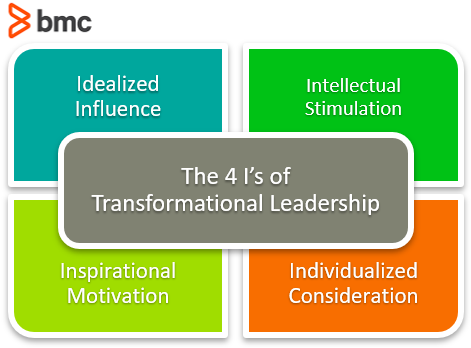Transformational Leadership is a concept for leaders to transform the workplace by inspiring team members to create change. Transformational leadership comes naturally to very few people—which means you can learn to become a transformational leader.
Let’s take a look at transformational leadership and how it works within the enterprise.
What is Transformational Leadership?
Transformational leadership is a style of leadership in which leaders encourage, inspire, and motivate employees to create change that overall helps to grow and shape the future success of a company. The executive level sets examples that contribute to three enterprise characteristics:
- Influential company culture
- Employee ownership
- An independent workplace without a level of micromanagement
Transformational Leaders lead with a level of trust to create a healthy work environment. This style trains staff members to take authority over decisions within their assigned jobs. This leadership style allows employees to:
- Be more creative
- Plan for future success
- Discover new solutions for problems that arise within their duties
Though Transformational Leadership might begin with the leader directly, it does not end there. Employees trained within this leadership style are also preparing to become transformational leaders themselves through company mentorship and training.
Thanks to its very nature—developing and delivering a team vision to change the culture of the company for the better—transformational leadership can be used especially in:
A brief history of Transformational Leadership

This leadership concept was expanded further during the 1980s by Bernard M. Bass, an American scholar in leadership studies and organizational behavior. Bass noted that the transformational leadership model inspired followers to:
- Reach a higher level on the consciousness towards the company’s goals
- Rise above their self-interest for the organization
- Approach a higher level of needs
Transformational leadership is also associated with the Servant Leadership philosophy notably embraced by Mahatma Gandhi, Nelson Mandela, and other historical figures.
The 4 I’s of Transformational Leadership
Bass suggests that transformational leadership involves four different elements, known today as the 4 I’s. These factors are crucial for any leader who wants to inspire, nurture, and develop their employees.

Let’s take a look at each factor.
Idealized Influence
Character: Promoting trust to earn respect
Idealized influence refers to how Transformational Leaders exert their weight within a group. A transformational leader must serve as a role model for their followers. Instilling trust and respect of the leader evokes the followers to emulate this individual and internalize the leader’s ideals.
Their team exceptionally respects these leaders because of the example they set forth for others. This type of leader also provides a clear vision and a sense of belonging, which encourages individuals to follow long-term objectives and drives them to achieve their own goals within the organization.
This leader is a powerful role model, and based on the example set, their team of followers will imitate this leader an aspire to become the leader.
Intellectual Stimulation
Character: Challenging the status quo
Intellectual stimulation means creating a diverse and open environment within the Transformation Leader’s organization. The setting is a space open to innovation and forming new ideas both for the company and for themselves.
The Transformational Leadership style challenges the status quo, encouraging team members to think outside of the box to reach their creative potential. This type of lead galvanizes their team to explore new ways of doing things and seek new opportunities to learn and grow within the organization.
This leadership style can play an influential role by openly pushing their followers to challenge their own beliefs and values (as well as those of the company) to stray from the norm.
Inspirational Motivation
Character: Encouraging, motivating, and inspiring others
Performance is a vital component of the Transformation Leadership style. A Transformational Leader must be able to motivate and inspire their team. This leadership plays the role of improving performance by encouraging their team’s morale through motivational techniques and presenting themselves as inspirational forces that drive their organization’s team members.
A Transformational Lead is a positive communicator of their high expectations to individual followers and encourages them on a solo level to gain their trust and commitment to the shared vision of the company’s goals and beliefs.
Instilling a clear vision that the Transformational Leader can voice to their team allows the leader to foster passion and motivation to meet their team member’s individual and the company’s goals.
Individualized Consideration
Character: Communicating openly to support all team members
Together with fostering an open environment, a Transformational Leader is actively seeking to create a diverse and supportive space. In this workspace, all individuals and their differences are respected and celebrated.
A leader of the Transformational leadership style offers support and encouragement to their team. Creating this growing supportive relationship involves a leader that keeps an open line of communication so that:
- Team members feel comfortable sharing ideas.
- Leaders can offer direct recognition of team member contributions.
Open communication allows for the lead to act as a mentor and coach for the team members continuing to work towards developing, empowering, and inspiring their team to achieve more.
This leader is always happy to listen to other’s concerns or needs of their team. Individual consideration is key to creating future leaders.
Benefits of Transformational Leadership
Both the leaders and the team members of Transformational Leadership experience many positive outcomes, including:
- Self-motivation
- Active engagement
- Higher productivity
- Personal and professional satisfaction
- Positive attitude
- Lower stress
How to become a Transformational Leader
Becoming a Transformational Leader is something you work at; it’s not something you either have—or don’t. Transformational Leaders actively embrace and commit to the 4 I’s to become a Transformational Leader.
To move towards Transformational Leadership, start by assessing your current leadership style. Consider how your strengths can benefit the team you are leading. Acknowledge your weaknesses and gaps and consider ways that you can overcome or limit these.
Some steps to developing your leadership style include:
- Understanding your own strengths and weaknesses
- Developing an inspiring vision for the future
- Motivating everyone around you
- Involving yourself in the Transformational Leadership concept
- Building trust and loyalty with your team members
Developing these tools of transformational leadership and working to improve you and your team’s areas of weakness to reach your overall goals can put you on a path to becoming a transformational leader.
Transformational leadership for the enterprise
The transformational leadership style can be hugely affected when used appropriately in a company or organization setting.
Every working environment is different. In some cases, a team or certain individuals may require a leadership style with more management that involves a closer eye and more significant direction, especially in a situation where team members may be less skilled or newer to the company.
Additional resources
For more on business leadership, explore these resources:
- BMC Business of IT Blog
- Guide to IT Leadership & Best Practices, with 10+ articles
- Guide to IT Careers
- What Is a Chief Service Officer (CSO)?
- CIO Leadership Styles
- Must-Read Emotional Intelligence Books for CIOs and IT Leaders







